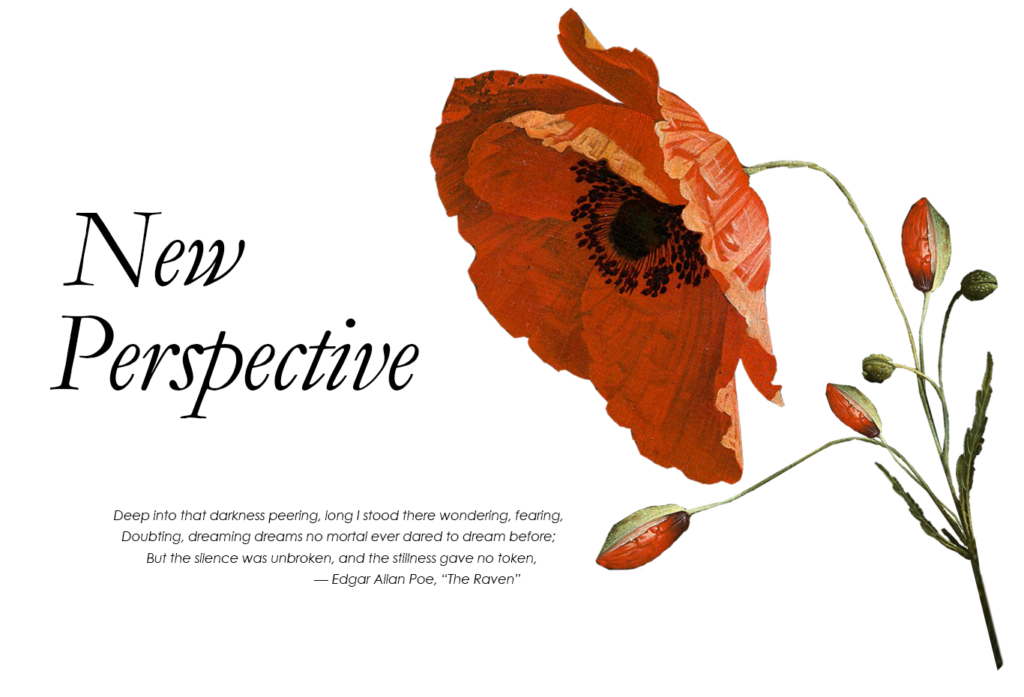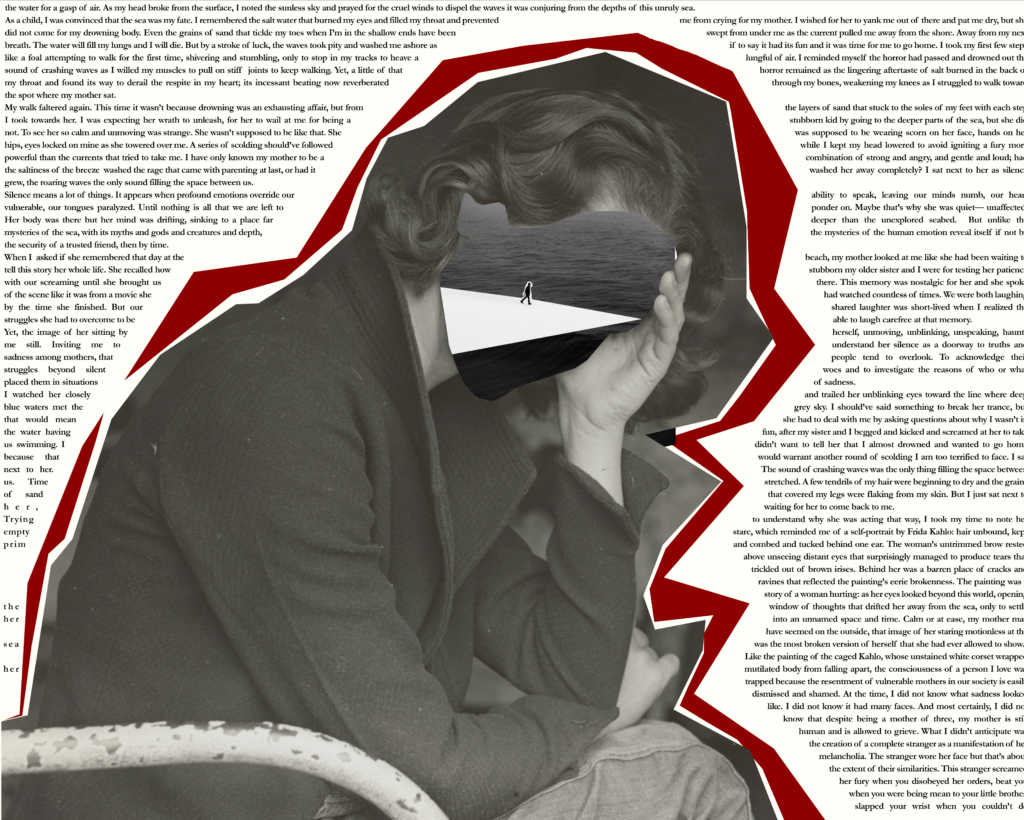
By Carmela Pacis | April 25, 2024
As a child, I was convinced that the sea was my fate. I remembered the salt water that burned my eyes and filled my throat, preventing me from crying out for my mother. I wished for her to yank me out of there and pat me dry, but she did not come for my drowning body. Even the grains of sand that tickle my toes when I’m in the shallow ends had been swept from under me as the current pulled me away from the shore. Away from my next breath. The water will fill my lungs and I will die. But by a stroke of luck, the waves took pity and washed me ashore as if to say it had its fun and it was time for me to go home. I took my first few steps like a foal attempting to walk for the first time, shivering and stumbling, only to stop in my tracks to heave a lungful of air. I reminded myself the horror had passed and drowned out the sound of crashing waves as I willed my muscles to pull on stiff joints to keep walking. Yet, a little of that horror remained as the lingering aftertaste of salt burned in the back of my throat and found its way to derail the respite in my heart; its incessant beating now reverberated through my bones, weakening my knees as I struggled to walk toward the spot where my mother sat.
My walk faltered again. This time it wasn’t because drowning was an exhausting affair, but from the layers of sand that stuck to the soles of my feet with each step I took towards her. I was expecting her to unleash her wrath, for her to wail at me for being a stubborn kid by going to the deeper parts of the sea, but she did not. To see her so calm and unmoving was strange. She wasn’t supposed to be like that. She was supposed to be wearing scorn on her face, hands on her hips, eyes locked on mine as she towered over me. A series of scolding should’ve followed while I kept my head lowered to avoid igniting a fury more powerful than the currents that had tried to take me. I have only known my mother to be a combination of strong and angry, gentle and loud; had the saltiness of the breeze washed the rage that came with parenting at last, or had it washed her away completely?
Silence means a lot of things. It appears when profound emotions override our ability to speak, leaving our minds numb, our heart vulnerable, our tongues paralyzed. Until nothing is all that we are left to ponder on. Maybe that’s why she was quiet—unaffected. Her body was there but her mind was drifting, sinking to a place far deeper than the unexplored seabed. But unlike the mysteries of the sea, with its myths and gods and creatures and depth, the mysteries of the human emotion reveal themselves if not by the security of a trusted friend, then by time.
When I asked her if she remembered that day at the beach, my mother looked at me like she had been waiting to tell this story her whole life. She recalled how stubborn my older sister and I were for testing her patience with our screaming until she brought us there. This memory was nostalgic for her and she spoke of the scene like it was from a movie she had watched countless of times. We were both laughing by the time she finished. But our shared laughter was short-lived when I realized the struggles she had to overcome to be able to laugh carefree at that memory. Growing up, I slept with the lights on. I slept with the lights on while my sister’s nebulizer sputtered and hummed, her incessant coughing and wheezing followed in pursuit to compose a tune that kept everyone from falling asleep. When I awoke, I ate breakfast on a table half filled with prescriptions. Each bottle labelled with a flavour I was tempted to try: there was lychee for my little brother, cherry, grape, strawberry, orange and banana for my sister. My mother had porcelain children she kept in bubble wrap, too fragile to play with, too pale to be allowed to swim in open waters.
I watched her closely and trailed her unblinking eyes toward the line where deep blue waters met the grey sky. I should’ve said something to break her trance, but then she would ask why I wasn’t in the water after my sister and I had tirelessly nagged her to take us swimming. I didn’t want to tell her that I almost drowned and wanted to go home because that would warrant another round of scolding I am too terrified to face. I sat next to her. The sound of roaring waves was the only thing filling the space between us. Time stretched. A few tendrils of my hair were beginning to dry and the grains of sand that covered my legs were flaking from my skin. But I just sat next to her, waiting for her to come back to me. Yet, that image of her sitting by herself, unmoving, unblinking, unspeaking, haunts me still. It was a glimpse of motherhood; the image of her inviting me to understand her silence as a doorway to truths and sadness among mothers, that people tend to overlook. To acknowledge their struggles beyond silent woes and to investigate the reasons of who or what placed them in situations of sadness.
“I did not know
what sadness
looked like.
I did not know
it had many faces.
Like the painting of the caged Kahlo, whose unstained white corset wrapped her mutilated body from falling apart, the consciousness of a person I love was trapped because the resentment of vulnerable mothers in our society is easily dismissed and shamed. At the time, I did not know what sadness looked like. I did not know it had many faces. And most certainly, I did not know that despite being a mother of three, my mother is still human and is allowed to grieve. What I didn’t anticipate was the creation of a complete stranger as a manifestation of her melancholia. The stranger wore her face but that’s about the extent of their similarities. This stranger screamed her fury when you disobeyed her orders, beat you when you were being mean to your little brother, slapped your wrist when you couldn’t do “simple” maths and locked you in your room until you were able to recite the English and Filipino alphabet like the back of your hand. At the time, I did not know what sadness looked like. I did not know it could look so horrifying or fragile.
I felt a sense of normalcy return to her body when I saw her eyes flutter. Her relaxed face started to crease with the familiar lines that always appeared when she furrowed her brows as she scanned her surroundings. She caught sight of my sister who had been knocked down by a wave. It took her another second to realize who sat next to her. But she finally looked at me with familiarity in her sharp eyes. “Come, let’s go home,” she said to me at last.
Listen to the author’s most played song while writing her piece:

Collage by Carmela Pacis
Carmela Pacis is an English and Professional Writing student at York University. She values storytelling and wants to write stories that celebrate individuality. Carmela spends most of her free time reading and scribbling on her journal but also enjoys her occasional bike rides around the city of Toronto.
